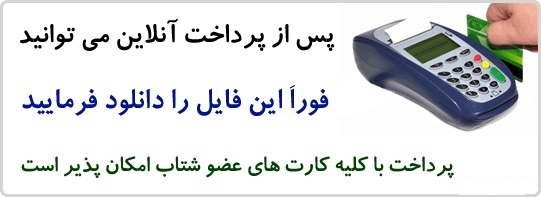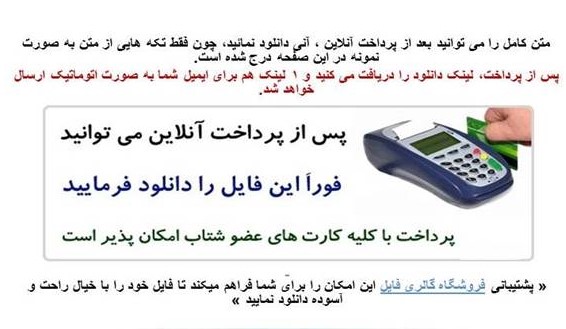دانلود با لینک مستقیم و پر سرعت .
لینک دانلود و خرید پایین توضیحات
فرمت فایل word و قابل ویرایش و پرینت
تعداد صفحات: 8
موضوع تحقیق:
(ایست قلبی)
List of Subject
Title:
What is Cardiac Arrest?
The problem of sudden cardiac Arrest
Resources
The American Heart Association urges the public to be prepared for cardiac emergencies:
Know the warning signs of cardiac arrest. During cardiac arrest a victim loses consciousness, stops normal breathing and loses pulse and blood pressure.
Call 9-1-1 immediately to access the emergency medical system if you see any cardiac arrest warning signs.
Give cardiopulmonary resuscitation (CPR) to help keep the cardiac arrest victim alive until emergency help arrives. CPR keeps blood and oxygen flowing to the heart and brain until defibrillation can be administered.
What is cardiac arrest?
Cardiac arrest is the sudden, abrupt loss of heart function. The victim may or may not have diagnosed heart disease. It's also called sudden cardiac arrest or unexpected cardiac arrest. Sudden death (also called sudden cardiac death) occurs within minutes after symptoms appear.
What causes cardiac arrest?
The most common underlying reason for patients to die suddenly from cardiac arrest is coronary heart disease. Most cardiac arrests that lead to sudden death occur when the electrical impulses in the diseased heart become rapid (ventricular tachycardia) or chaotic (ventricular fibrillation) or both. This irregular heart rhythm (arrhythmia) causes the heart to suddenly stop beating. Some cardiac arrests are due to extreme slowing of the heart. This is called brady cardiac.
Other factors besides heart disease and heart attack can cause cardiac arrest. They include respiratory arrest, electrocution, drowning, choking and trauma. Cardiac arrest can also occur without any known cause.
Can cardiac arrest be reversed?
Brain death and permanent death start to occur in just 4 to 6 minutes after someone experiences cardiac arrest. Cardiac arrest can be reversed if it's treated within a few minutes with an electric shock to the heart to restore a normal heartbeat. This process is called defibrillation. A victim's chances of survival are reduced by 7 to 10 percent with every minute that passes without defibrillation. Few attempts at resuscitation succeed after 10 minutes.
How many people survive cardiac arrest?
No statistics are available for the exact number of cardiac arrests that occur each year. It's estimated that more than 95 percent of cardiac arrest victims die before reaching the hospital. In cities where defibrillation is provided within 5 to 7 minutes, the survival rate from sudden cardiac arrest is as high as 49 percent.
What can be done to increase the survival rate?
Early CPR and rapid defibrillation combined with early advanced care can result in high long-term survival rates for witnessed cardiac arrest. For instance, in June 1999, automated external defibrillators (AEDs) were mounted 1 minute apart in plain view at Chicago's O'Hare and Midway airports. In the first 10 months, 14 cardiac arrests occurred, with 12 of the 14 victims in ventricular fibrillation. Nine of the 14 victims (64 percent) were revived with an AED and had no brain damage.
If bystander CPR was initiated more consistently, if AEDs were more widely available, and if every community could achieve a 20 percent cardiac arrest survival rate, an estimated 40,000 more lives could be saved each year. Death from sudden cardiac arrest is not inevitable. If more people react quickly by calling 9-1-1 and performing CPR, more lives can be saved.
Related AHA publications:
Heart and Stroke Facts
Heart Disease and Stroke Statistics Update








